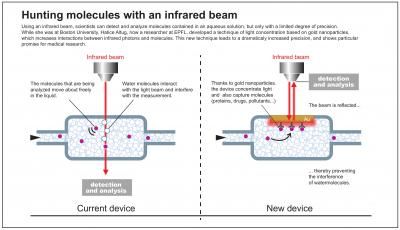Advance toward earlier detection of melanoma
Scientists are reporting development of a substance to enhance the visibility of skin cancer cells during scans with an advanced medical imaging system that combines ultrasound and light. The hybrid scanner could enable doctors to detect melanoma, the most serious form of skin cancer, in its earliest and most curable stages, the report in ACS Nano indicates.
Lihong Wang, Younan Xia, and colleagues point out that early diagnosis is key to improving survival in patients with melanoma. The five-year survival rate for melanoma is about 98 percent if detected early but can be as low as 15 percent when detected at an advanced stage. Existing imaging techniques for early detection of melanoma produce low-quality images, can "see" only a fraction of an inch below the skin, and use potentially harmful radioactive materials. A promising new technique called photoacoustic tomography (PAT) can overcome these problems. The system shoots light into tumors, which slightly heats up the cancer cells and produces high frequency sound waves that provide images of the tumor. But the PAT system lacks an optimal contrast agent that can easily enter skin cancer cells and make them visible.
The scientists developed such an agent by attaching a peptide (one of the building blocks of proteins) that targets skin cancer cells to gold "nanocages." These hollow gold nanoparticles have a box-like shape and are barely 1/50,000th the width of a human hair. When injected into mice with skin cancer, the nanocages improved the image quality of the cancer cells by three-fold compared to nanoparticles lacking the peptide. The gold nanocages also show promise as a way to kill skin cancer cells using heat or anti-cancer drugs, they add.
Topics
Organizations
Other news from the department science
These products might interest you

Eclipse by Wyatt Technology
FFF-MALS system for separation and characterization of macromolecules and nanoparticles
The latest and most innovative FFF system designed for highest usability, robustness and data quality

DynaPro Plate Reader III by Wyatt Technology
Screening of biopharmaceuticals and proteins with high-throughput dynamic light scattering (DLS)
Efficiently characterize your sample quality and stability from lead discovery to quality control

Get the life science industry in your inbox
By submitting this form you agree that LUMITOS AG will send you the newsletter(s) selected above by email. Your data will not be passed on to third parties. Your data will be stored and processed in accordance with our data protection regulations. LUMITOS may contact you by email for the purpose of advertising or market and opinion surveys. You can revoke your consent at any time without giving reasons to LUMITOS AG, Ernst-Augustin-Str. 2, 12489 Berlin, Germany or by e-mail at revoke@lumitos.com with effect for the future. In addition, each email contains a link to unsubscribe from the corresponding newsletter.
Most read news
More news from our other portals
Last viewed contents

Cancer: When viruses and bacteria cooperate - HPV and Chlamydia: a malicious alliance driving cellular transformation

Integrated approach streamlines genome sequencing to advance single-cell technology

A “chemical ChatGPT” for new medications - AI learns chemical connections
MHH Researchers scrutinize EC Regulation - 500.000 Euros of funding for an assessment of regulatory impact on Advanced Therapies
Roche to acquire Kapa Biosystems
Powering off TB: New electron transport gene is a potential drug target
Aortic aneurysm treatable with asthma drugs
TSRI scientists take step toward mapping how the brain stores memories

New study on the male contraceptive pill - Researchers launch contraceptive startup
Crucell Gains Approval and Moves to Recruitment for West Nile Vaccine Phase I Clinical Study



















































